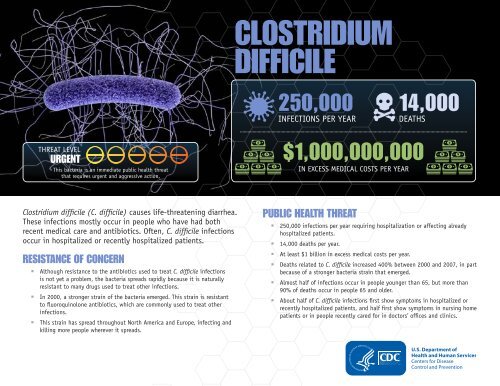Antibiotic Resistance Threats in the United States, 2013 report
Antibiotic Resistance Threats in the United States, 2013 report
Antibiotic Resistance Threats in the United States, 2013 report
You also want an ePaper? Increase the reach of your titles
YUMPU automatically turns print PDFs into web optimized ePapers that Google loves.
CLOSTRIDIUM<br />
DIFFICILE<br />
250,000<br />
INFECTIONS PER YEAR<br />
14,000<br />
DEATHS<br />
THREAT LEVEL<br />
URGENT<br />
This bacteria is an immediate public health threat<br />
that requires urgent and aggressive action.<br />
$1,000,000,000<br />
IN EXCESS MEDICAL COSTS PER YEAR<br />
Clostridium difficile (C. difficile) causes life-threaten<strong>in</strong>g diarrhea.<br />
These <strong>in</strong>fections mostly occur <strong>in</strong> people who have had both<br />
recent medical care and antibiotics. Often, C. difficile <strong>in</strong>fections<br />
occur <strong>in</strong> hospitalized or recently hospitalized patients.<br />
RESISTANCE OF CONCERN<br />
■■<br />
■■<br />
■■<br />
Although resistance to <strong>the</strong> antibiotics used to treat C. difficile <strong>in</strong>fections<br />
is not yet a problem, <strong>the</strong> bacteria spreads rapidly because it is naturally<br />
resistant to many drugs used to treat o<strong>the</strong>r <strong>in</strong>fections.<br />
In 2000, a stronger stra<strong>in</strong> of <strong>the</strong> bacteria emerged. This stra<strong>in</strong> is resistant<br />
to fluoroqu<strong>in</strong>olone antibiotics, which are commonly used to treat o<strong>the</strong>r<br />
<strong>in</strong>fections.<br />
This stra<strong>in</strong> has spread throughout North America and Europe, <strong>in</strong>fect<strong>in</strong>g and<br />
kill<strong>in</strong>g more people wherever it spreads.<br />
PUBLIC HEALTH THREAT<br />
■■<br />
■■<br />
■■<br />
■■<br />
■■<br />
■■<br />
250,000 <strong>in</strong>fections per year requir<strong>in</strong>g hospitalization or affect<strong>in</strong>g already<br />
hospitalized patients.<br />
14,000 deaths per year.<br />
At least $1 billion <strong>in</strong> excess medical costs per year.<br />
Deaths related to C. difficile <strong>in</strong>creased 400% between 2000 and 2007, <strong>in</strong> part<br />
because of a stronger bacteria stra<strong>in</strong> that emerged.<br />
Almost half of <strong>in</strong>fections occur <strong>in</strong> people younger than 65, but more than<br />
90% of deaths occur <strong>in</strong> people 65 and older.<br />
About half of C. difficile <strong>in</strong>fections first show symptoms <strong>in</strong> hospitalized or<br />
recently hospitalized patients, and half first show symptoms <strong>in</strong> nurs<strong>in</strong>g home<br />
patients or <strong>in</strong> people recently cared for <strong>in</strong> doctors’ offices and cl<strong>in</strong>ics.
















